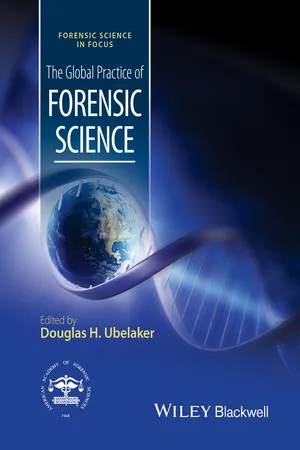
- English
- ePUB (mobile friendly)
- Available on iOS & Android
The Global Practice of Forensic Science
About This Book
The Global Practice of Forensic Science presents histories, issues, patterns, and diversity in the applications of international forensic science. Written by 64 experienced and internationally recognized forensic scientists, the volume documents the practice of forensic science in 28 countries from Africa, the Americas, Asia, Australia and Europe. Each country's chapter explores factors of political history, academic linkages, the influence of individual cases, facility development, types of cases examined, integration within forensic science, recruitment, training, funding, certification, accreditation, quality control, technology, disaster preparedness, legal issues, research and future directions. Aimed at all scholars interested in international forensic science, the volume provides detail on the diverse fields within forensic science and their applications around the world.
Frequently asked questions
Information
CHAPTER 1
Introduction
1.1 Chapter organization and information
- The title of each chapter should include the name of the country being discussed. For example, “The practice of forensic science in Argentina” or “History and current status of forensic science in Argentina.” The chapters will be presented in the volume in alphabetical order by country.
- Each chapter should contain information on all of the forensic sciences, to include:
Criminalistics, Digital and Multimedia Sciences, Engineering Sciences, Odontology, Pathology/Bio- logy (including DNA and entomology), Anthropology/Archaeology, Psychiatry and Behavioral Science, Questioned Documents and Toxicology.
- Each chapter should address the following topics:
- History within the country. This section can inc- lude history of key organizations within the country as appropriate.
- Types of cases. Some information would be helpful on the variation of types of cases examined with statistical summaries as available.
- Structure. How are forensic science initiatives organized within the country? Are they centralized within a particular institution or agency or more diversely organized?
- Integration of forensic science. How is integration of forensic science achieved in crime scene investigation, case analysis, report writing and legal presentation? Are teams organized of the various specialties or are separate reports generated for integration later?
- Recruitment. By what process are new forensic scientists hired or encouraged to enter the field?
- Training. How do forensic scientists acquire the necessary education? Do universities within the country offer courses/training/degrees in the forensic sciences? Are training programs conducted by forensic institutions?
- Funding. A brief discussion of funding issues would be useful. Are funding sources through the national government or through other channels? What factors impact funding for forensic science? Who decides on the budgets for forensic science and prioritizes the use of funds?
- Political influences. How does the political climate and shifts in political orientations affect the practice of forensic science?
- Certification. What certification programs exist for individual forensic scientists? By what process are the qualifications of forensic practitioners evaluated?
- Laboratory accreditation/quality control. What procedures are in place for accreditation of laboratories and quality control? How do these vary within disciplines?
- Technology. What are the key technology issues that affect the practice of forensic science?
- Disaster preparedness. What plans are in place for disaster preparedness?
- Legal issues. How does forensic perspective enter the legal arena? What court procedures affect presentations of forensic science?
- Research. What key research is being conducted and by what process?
- Future directions. What do you see as the key challenges facing forensic science in the country and what trends are apparent?
CHAPTER 2
The practice of forensic sciences in Argentina

2.1 Introduction: the Argentine nation
Table of contents
- Cover
- Title Page
- Copyright
- About the editor
- List of contributors
- Foreword
- Series preface
- Chapter 1: Introduction
- Chapter 2: The practice of forensic sciences in Argentina
- Chapter 3: Australia
- Chapter 4: Forensic sciences in Canada
- Chapter 5: The Chilean Forensic Medical Service
- Chapter 6: Forensic science in Colombia
- Chapter 7: Forensic science in Denmark
- Chapter 8: The practice of forensic science in Egypt: a story of pioneering
- Chapter 9: The practice of forensic science in Estonia
- Chapter 10: History and current status of forensic science and medicine in Finland
- Chapter 11: Forensic medicine in France
- Chapter 12: Forensic medicine in Germany
- Chapter 13: Forensic science in Hong Kong
- Chapter 14: The practice of forensic science in Hungary
- Chapter 15: Forensic science in India
- Chapter 16: Forensic sciences in Italy
- Chapter 17: History and current status of forensic science in Japan
- Chapter 18: Forensic science in Korea
- Chapter 19: Forensic medicine in Libya
- Chapter 20: The practice of forensic science in Mexico
- Chapter 21: The Netherlands
- Chapter 22: History and current status of forensic science in Singapore
- Chapter 23: The history and current status of forensic science in South Africa
- Chapter 24: Forensic science practice in Spain
- Chapter 25: Legal medicine and forensic science in Switzerland
- Chapter 26: Forensic medicine and sciences in Turkey
- Chapter 27: Forensic medicine in the United Arab Emirates
- Chapter 28: Forensic science practice in the United States
- Chapter 29: Legal medicine and forensic science in Uruguay
- Chapter 30: Conclusions: global common themes and variations
- Index
- End User License Agreement